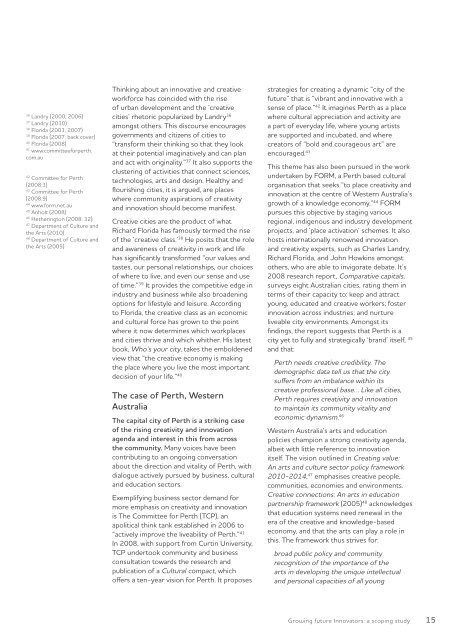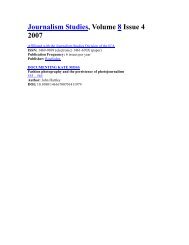GrowinG Future innovators - ARC Centre of Excellence for Creative ...
GrowinG Future innovators - ARC Centre of Excellence for Creative ...
GrowinG Future innovators - ARC Centre of Excellence for Creative ...
Create successful ePaper yourself
Turn your PDF publications into a flip-book with our unique Google optimized e-Paper software.
36 Landry (2000, 2006)<br />
37 Landry (2010)<br />
38 Florida (2003, 2007)<br />
39 Florida (2007: back cover)<br />
40 Florida (2008)<br />
41 www.committee<strong>for</strong>perth.<br />
com.au<br />
42 Committee <strong>for</strong> Perth<br />
(2008:3)<br />
43 Committee <strong>for</strong> Perth<br />
(2008:9)<br />
44 www.<strong>for</strong>m.net.au<br />
45 Anholt (2008)<br />
46 Hetherington (2008: 32)<br />
47 Department <strong>of</strong> Culture and<br />
the Arts (2010)<br />
48 Department <strong>of</strong> Culture and<br />
the Arts (2005)<br />
Thinking about an innovative and creative<br />
work<strong>for</strong>ce has coincided with the rise<br />
<strong>of</strong> urban development and the ‘creative<br />
cities’ rhetoric popularized by Landry 36<br />
amongst others. This discourse encourages<br />
governments and citizens <strong>of</strong> cities to<br />
“trans<strong>for</strong>m their thinking so that they look<br />
at their potential imaginatively and can plan<br />
and act with originality.” 37 It also supports the<br />
clustering <strong>of</strong> activities that connect sciences,<br />
technologies, arts and design. Healthy and<br />
flourishing cities, it is argued, are places<br />
where community aspirations <strong>of</strong> creativity<br />
and innovation should become manifest.<br />
<strong>Creative</strong> cities are the product <strong>of</strong> what<br />
Richard Florida has famously termed the rise<br />
<strong>of</strong> the ‘creative class.’ 38 He posits that the role<br />
and awareness <strong>of</strong> creativity in work and life<br />
has significantly trans<strong>for</strong>med “our values and<br />
tastes, our personal relationships, our choices<br />
<strong>of</strong> where to live, and even our sense and use<br />
<strong>of</strong> time.” 39 It provides the competitive edge in<br />
industry and business while also broadening<br />
options <strong>for</strong> lifestyle and leisure. According<br />
to Florida, the creative class as an economic<br />
and cultural <strong>for</strong>ce has grown to the point<br />
where it now determines which workplaces<br />
and cities thrive and which whither. His latest<br />
book, Who’s your city, takes the emboldened<br />
view that “the creative economy is making<br />
the place where you live the most important<br />
decision <strong>of</strong> your life.” 40<br />
The case <strong>of</strong> Perth, Western<br />
Australia<br />
The capital city <strong>of</strong> Perth is a striking case<br />
<strong>of</strong> the rising creativity and innovation<br />
agenda and interest in this from across<br />
the community. Many voices have been<br />
contributing to an ongoing conversation<br />
about the direction and vitality <strong>of</strong> Perth, with<br />
dialogue actively pursued by business, cultural<br />
and education sectors.<br />
Exemplifying business sector demand <strong>for</strong><br />
more emphasis on creativity and innovation<br />
is The Committee <strong>for</strong> Perth (TCP), an<br />
apolitical think tank established in 2006 to<br />
“actively improve the liveability <strong>of</strong> Perth.” 41<br />
In 2008, with support from Curtin University,<br />
TCP undertook community and business<br />
consultation towards the research and<br />
publication <strong>of</strong> a Cultural compact, which<br />
<strong>of</strong>fers a ten-year vision <strong>for</strong> Perth. It proposes<br />
strategies <strong>for</strong> creating a dynamic “city <strong>of</strong> the<br />
future” that is “vibrant and innovative with a<br />
sense <strong>of</strong> place.” 42 It imagines Perth as a place<br />
where cultural appreciation and activity are<br />
a part <strong>of</strong> everyday life, where young artists<br />
are supported and incubated, and where<br />
creators <strong>of</strong> “bold and courageous art” are<br />
encouraged. 43<br />
This theme has also been pursued in the work<br />
undertaken by FORM, a Perth based cultural<br />
organisation that seeks “to place creativity and<br />
innovation at the centre <strong>of</strong> Western Australia’s<br />
growth <strong>of</strong> a knowledge economy.” 44 FORM<br />
pursues this objective by staging various<br />
regional, indigenous and industry development<br />
projects, and ‘place activation’ schemes. It also<br />
hosts internationally renowned innovation<br />
and creativity experts, such as Charles Landry,<br />
Richard Florida, and John Howkins amongst<br />
others, who are able to invigorate debate. It’s<br />
2008 research report, Comparative capitals,<br />
surveys eight Australian cities, rating them in<br />
terms <strong>of</strong> their capacity to: keep and attract<br />
young, educated and creative workers; foster<br />
innovation across industries; and nurture<br />
liveable city environments. Amongst its<br />
findings, the report suggests that Perth is a<br />
city yet to fully and strategically ‘brand’ itself, 45<br />
and that:<br />
Perth needs creative credibility. The<br />
demographic data tell us that the city<br />
suffers from an imbalance within its<br />
creative pr<strong>of</strong>essional base… Like all cities,<br />
Perth requires creativity and innovation<br />
to maintain its community vitality and<br />
economic dynamism. 46<br />
Western Australia’s arts and education<br />
policies champion a strong creativity agenda,<br />
albeit with little reference to innovation<br />
itself. The vision outlined in Creating value:<br />
An arts and culture sector policy framework<br />
2010-2014, 47 emphasises creative people,<br />
communities, economies and environments.<br />
<strong>Creative</strong> connections: An arts in education<br />
partnership framework (2005) 48 acknowledges<br />
that education systems need renewal in the<br />
era <strong>of</strong> the creative and knowledge-based<br />
economy, and that the arts can play a role in<br />
this. The framework thus strives <strong>for</strong>:<br />
broad public policy and community<br />
recognition <strong>of</strong> the importance <strong>of</strong> the<br />
arts in developing the unique intellectual<br />
and personal capacities <strong>of</strong> all young<br />
Growing future Innovators: a scoping study 15




![Plebiscite (Riegert chapter) revised FINAL [Feb 14].pdf](https://img.yumpu.com/8710373/1/190x245/plebiscite-riegert-chapter-revised-final-feb-14pdf.jpg?quality=85)